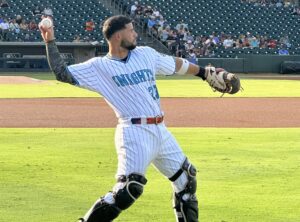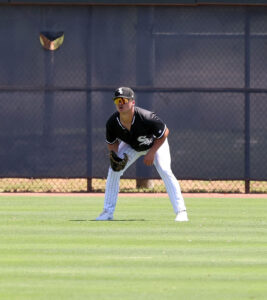Sox Blogger Call with Dan Fabian
Dan Fabian, the Director of Baseball Operations for the Chicago White Sox, was kind enough to stop by for a quick Q&A with a few White Sox related blogs. Dan will be entering his 21st season in the White Sox baseball department. Here are some highlights from the conversation…
About new advanced analytics from MLB: “We haven’t seen a lot of it yet, and much of it is actually quite surprising to us. Primarily, we’re focused on having a few of our guys testing it, including catcher framing.”
Regarding the White Sox beliefs on initial catch-framing runs prevented: “The initial runs prevented seemed very high for such a small sample size, though the Baseball Prospectus article outlining the beliefs seemed to be more in line with what our guys have seen.”
If there has been a change in philosophy regarding Stats vs Scouting since Rick Hahn was named GM: “We’ve always been an organization that looks at both aspects. We will always look towards the scouting reports first, and from there we will move towards the statistical side of things. At times, Rick may go deeper into the statistics [than Ken Williams], but ultimately, we will always use the scouting reports first followed by the statistics.”
On how Scouting versus Stats played for Jose Abreu: “He was another guy that we looked at both. Both Marco Paddy [International Operations] and Ken Williams saw his workout in Miami and came away incredibly impressed, and Marco has seen a lot of him in international play as well. We also obviously know what he did in the Cuban League, and overall we had very good scouting reports and statistics on him that we believe he is a guy that we can plug in to play in the middle of the order as a very good hitter and the power too as you saw yesterday.”
On whether the stats will sometimes bring the Sox looking back at scouting reports: “Sometimes, but typically, our initial belief in the scouting reports will remain true. Sometimes, a guy may have made an adjustment to his game and our scouting reports will change, and if guys are performing well enough we may go back and take a second look, but with the amount of information we have now a days, it makes it much easier to see what exactly is happening. Still, it’s amazing how much quicker and more easily accessible statistics are compared to when we started. I don’t even know how we did our jobs 20 years ago!”
Regarding the draft (the Sox have a top 5 pick for the first time since 1990): “We have a list of our top 5 guys right now, and we’ve pretty much scouted every game that those guys have played. With the first top 5 pick in almost 25 years, it’s something that you absolutely want to get right. When you’re picking in the 20’s, there’s a bit more guesswork involved but with this, we have to be very sure, and we do trust the scouting reports of our guys. They’ve done a great job, even going deeper into the draft, and we’ve been really happy with our drafts the past couple of years regarding the quality of players we’ve brought in.”
On Courtney Hawkins: “He’s been making a lot of the adjustments we’ve wanted him to. Obviously, last year was really hard for him, but we’re working with him standing back and working to the opposite field. He’s been making better contact and working that way, and that’s making him a better hitter plus he still has the massive power as we all saw last year. In fact, our guys were raving about how far he hit a ball out to right center field. Still, it’s a learning curve and it’s always making adjustments, and for some people, that learning curve is longer for some than others. We still really like what we have with Courtney and feel he’s going to be a good player for us.”
On the hiring of Todd Steverson and hitting in general: “Todd has been very good thus far working with our hitters, both at the major league level and the minors, and both Rick and Todd want to see that philosophy move through the organization. In the past we’ve had some on-base issues, but some of what Todd has been doing is trying to get hitters to be more comfortable in the box deeper into the count. Obviously, if you can do that, you will start fighting off pitches and taking more walks in general, and that’s something we are trying to incorporate up and down the system.”
If there has been any change in evaluation since the steroid era: “The evaluation has never really changed, but we firmly believe – and always have – that on-base percentage drives the offense. There are other characteristics and because of our home park, our homer totals will always be a bit higher, but that’s also something we try and look at when evaluating pitchers, especially our bullpen arms. Both [Ronald] Belisario and [Daniel] Webb are big time power sinker guys that can work late in games that we feel will keep the ball in the ballpark, and in general that’s something we’re looking for in all of our pitchers.”
On the installation of replay in baseball and if his guys are looking at possible flaws in the system: “Primarily, our guys are trying to look at the appropriate times to challenge plays and when it makes sense to actually challenge the call on the field. Thus far, we’ve found that there just haven’t been that many times when it has actually been needed. As you’ve seen, there haven’t been many calls overturned thus far in Spring Training, but that may change in the regular season. As we have more exposure to it and grow more accustomed to it, we will make adjustments to our philosophy as we go.”
On what he does when watching games on a day to day basis: “I’ve sort of developed a routine where I’ll keep score as I go because I find that it helps me recall things that happen during the games much better than if I’m not. I’ll also pay particular attention during different situations so I can see how players perform as well and to see if I see what our other guys see when they’re watching the games. I will also have games up on my iPad to either watch other games throughout the majors and minors to get a look at other guys that we want to see a little more of as well.”
On evaluating character in scouting reports: “It’s something we take very seriously. Regarding certain players, we’ll talk to scouts, coaches, and current and former teammates to help us better evaluate how they’ll fit with our system. Adrien Nieto was one of those guys. We talked to our scouts as well as other amateur scouts who have seen him, and we had guys in Miami asking people what he was about, and we really liked what he brought.”
On the value of a closer: “Primarily, we always want to look at the depth of our bullpen. Nowadays, you will typically see closers come into the 9th with a clean slate and a two to three run lead, and the conversion rate in those situations is extremely high. A lot of times, we find that the toughest outs come in the 7th and 8th innings. In 2005, when we won it all, we had three different closers, as Bobby Jenks didn’t come up until late in the year, and then Neal Cotts and Cliff Politte did tremendous work for us in those later innings as well. Right now, we feel we have quite a few guys who can fill that role. Lindstrom has some experience in the roll, Belisario has the arm for it, Webb is a guy that we believe can do the job at some point, and then there’s Nate Jones as well. A lot of people believe it’s ‘A to B to C’ and what we are looking at trying to do is to just find roles for these guys that they can handle.
“You look at Addison Reed, and we really liked what Addison did for us, but this offseason, we were able to trade him for a guy in Matt Davidson that we really liked. We had 3 different scouts all say the same thing – that he’s a very good hitter at third base, and we felt that, ultimately, he was just too good of a hitter to pass up with that power at third base.”
On the new minor league parks in Birmingham and Charlotte and how they’ll play: “I have no idea what Charlotte’s will look like. We think it will play pretty fair compared to the old park and the 340 feet power alleys where a fly ball could end up as a homer, but I’m not a wind chart expert, so until we see it in live action, we just really don’t know. Birmingham I think still plays pretty big, though not as big in the past. We have found that small parks cause some issues for pitchers, but these guys will have to pitch in all kinds of ballparks, and our park in Chicago hasn’t always been kind to pitchers either. It’s all about the adjustments that they have to make.
“We are so fortunate to have these new parks, plus a 4 year old park in Winston-Salem, we just feel really blessed that these new facilities are opening up. On top of that, the new facilities themselves are great, weight rooms and training areas, that we feel our prospects are in as good of a situation as you can be in.”





